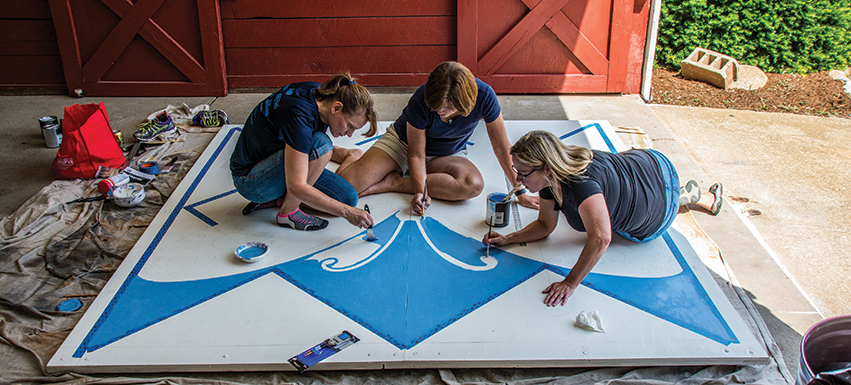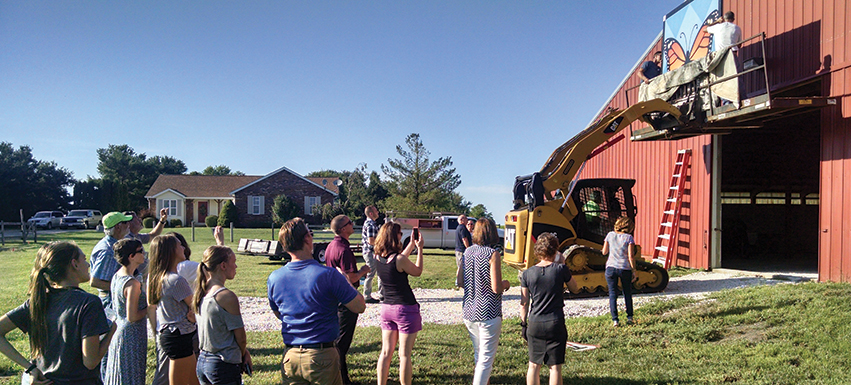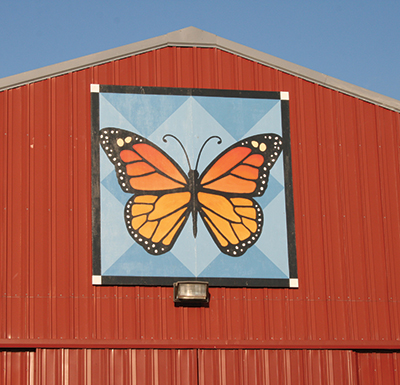A new kind of folk art aids one couple’s butterfly conservation efforts.
If you enjoy leaving behind busy highways for the scenic routes of the countryside, you may have spotted barns adorned with large, square blocks painted with colorful patterns. Commonly known as “barn quilts,” they are quickly becoming a fixture on the rural American landscape. While they come in a variety of shapes, the classic barn quilt is 8’ x 8’ square—and nearly all of them feature a quilt-like pattern.
The art of barn embellishment has a long history in the United States, beginning more than 200 years ago with the arrival of German and Swiss immigrants in Pennsylvania. In the early 19th century—as paint became affordable to the average person—the Pennsylvania Dutch began to paint their barns with colorful, geometric patterns known as “hex” signs. Later, barns were often used as advertising space, highlighting restaurants, brands and local attractions, but over time, many of them fell into disrepair—leaving behind only ghostly images of the past.
One might assume today’s barn quilts have had a long history in this country, but they are actually a very recent development in American folk art. The woman who started the movement, Donna Sue Groves, was inspired by the quilt-like patterns she saw on restored Pennsylvania Dutch barns, and worked with her community to create the very first “barn quilt trail” in Adams County, Ohio, in 2001.
Fifteen years later, what started with 20 barns in Ohio has spread to nearly every state and Canada—including nearby trails in McLean and DeWitt counties—and America’s countryside was alive with traditional artwork once again. Although Peoria, Woodford and Tazewell counties do not have barn quilt trails of their own, that could soon change—thanks in part to a serendipitous chain of events that led to the creation of a barn quilt at a butterfly conservation area in rural Washington, Illinois.

Photo by Jim Burnham
A Home for Pollinators
Passionate about habitat preservation, Mitch and Charli Gregory have been involved with conservation organizations for decades. “I have always been a conservationist,” Mitch explains. “I learned it at a very early age from my grandparents.” In 1982, he joined Pheasants Forever, a nonprofit organization dedicated to the conservation of pheasants, quail and other wildlife. “I’ve always been more interested in how nature takes care of itself,” he notes. “If you provide the right atmosphere, it does very well.”
With the desire to create butterfly-friendly habitat on their property, the Gregorys have converted 33 acres of farmland to native prairie, starting out with four acres. “We planted 75% grass seed and 25% flower seed,” Mitch remarks, “but when we converted the rest of the land, we switched those numbers.” The result was expansive fields of pollinator-friendly flowers and plants, including milkweed—the plant on which monarchs lay their eggs, and the exclusive source of food for monarch caterpillars.
“I lived through the great era of the monarch,” Mitch recalls. “I remember when you could get jars of them. I also lived through the time when Roundup herbicide use began.”
According to the USDA, the North American monarch population has dropped dramatically, from about a billion in 1995 to just 34 million today. Because this phenomenon has been widely attributed to the use of herbicides in farming, many conservationists are encouraging the public to plant milkweed in their yards and fields—a way to help reverse the monarch’s decline. At the same time, prairie plants like milkweed are beneficial not only for pollinators; they provide food and shelter for a variety of wildlife throughout the four seasons.
“As the plants fall over, they become nests for birds, animals and insects,” explains Charli Gregory. In the winter, the seed heads emerge high above the snowdrifts, offering shelter and sustenance for wintering birds. In addition, the Gregorys now have beehives on their 33 acres, providing a home to around 30,000 bees—another essential pollinator whose recent population decline has caused alarm. Their secret? “It just takes people getting involved,” Mitch explains.
Raising the Monarch
About the same time, unbeknownst to the Gregorys, a long-time acquaintance of theirs was inspired to spread the word about the plight of the monarch. Linda Webb, an illustrator and artist, also from Washington, was encouraged by friends to enter her clay mosaic work in the ArtPop Peoria 2016 competition, which places local artwork on empty billboard space. With a desire to create something new, she was in need of inspiration—but the deadline was quickly approaching.
“I was running out of time and I didn’t have any good ideas,” Linda recalls. “I talked to a friend who is on a butterfly task force, and I thought… I should make a butterfly!” With visions of her artwork high up on a billboard, she also saw it as an opportunity to promote conservation efforts, and worked quickly to create a clay mosaic of a monarch butterfly. “I wanted to win,” she admits, smiling.
Not only did the resulting image, “Migrating Monarchs,” go on to win the ArtPop Peoria People’s Choice Award, it also caught the attention of local arts advocates Kip and Ann Strasma. “I thought, if we could get some visual version of Linda’s artwork on Mitch Gregory’s barn, it would be a welcoming sign for anyone who wanted to come visit—a symbol of what the land represents,” Kip explains. The planning began quickly… but first they had to determine how to attach Linda’s artwork to the Gregory barn.
They discussed a variety of options—from using a printed vinyl version of the ArtPop mosaic to painting directly onto the barn—but could not reach a consensus. “I wasn’t going to get up there on a 40-foot ladder, so we just started thinking of different ideas,” Linda recalls. Then a friend gave her a brochure about a barn quilt trail, and everything clicked. “That was the ‘light bulb’ moment for the barn quilt,” she laughs. “Paint it on the ground—not on a ladder!”

Photo by Jim Burnham
One of the appeals of barn quilts is their individuality—though most are square, each is designed to convey something about its owners. Linda’s piece is no different, embracing the traditional, folk-art aspect of barn quilts while highlighting the monarch’s dilemma, a cause embraced by the Gregorys.
“It is contemporary… but if you look closely, it has a quilt pattern in the background,” Linda explains. Wanting the butterfly to be perfectly symmetrical, she used software to enlarge her 1” x 1” square drawing to the size of the 8’ x 8’ square canvas, and printed the pattern. “I only printed out half of the butterfly,” she clarifies. “It took over 40 sheets of paper. I taped it together, cut it out and had a perfectly scaled template.”
After Mitch primed the canvas for her, the monarch was painted in bright hues of orange and black, set against a serene, sky-blue quilted background. “I had a team of painters who helped paint it,” Linda recalls. “And friends even came to watch!” Then, in the spirit of traditional barn raisings—when a community joins together to build a barn for one of its neighbors—the Gregorys invited friends to join them for a “barn quilt raising” in order to attach Linda’s work to the barn. According to Mitch, it was the highlight of the process.
“This is what was interesting to me: the fact that people are getting together to do something like this,” he notes with characteristic enthusiasm. “It was fun… which makes you [even] more motivated about the purpose behind it.”
The Multiplying Impact
This story could end there, but it hasn’t yet. Linda Webb’s artwork has taken on a life of its own as other groups seek her assistance in promoting their own conservation efforts. The Peoria Garden Club, for example, recently received a grant from the Community Foundation of Central Illinois to create sidewalk chalk stencils using her butterfly designs—a way to encourage the public to plant native milkweed. And while the educational materials will be available at various locations in Peoria, they will also soon show up on sidewalks at Illinois rest areas—at IDOT’s request.
Meanwhile, everyone involved with Webb’s barn quilt believes the Peoria area is primed for its own barn quilt trail. “It gives the artist a completely different avenue to expose the art, and have a different platform,” observes Ann Strasma.
“We’d like to do more barn quilts,” Linda adds. “Eventually, it would be great if Peoria had its own trail. Once it gets in your head, it’s all I can do to stop myself from knocking on doors!”
And for Kip Strasma, who brought the group together, it’s all about collaboration—the potential to multiply the impact of one good idea into many others. While Linda Webb’s original ArtPop mosaic was created as a celebration of art, it is now also an essential component of multiple conservation efforts, as well as educational materials—and the impetus behind a movement to bring a new kind of folk art to the region.
“I think it’s a symbol of what can happen,” he observes. “Why do something for one reason, when you can do it for four or five reasons?” a&s
Check out mcleancountybarnquilts.com or barnquiltsofdewittcounty.com to learn more about the barn quilt trails in McLean and DeWitt counties—and visit barnquiltinfo.com to find trails all over the country. Find “Central Illinois Barn Quilts” on Facebook to learn more about barn quilts located in Peoria, Woodford and Tazewell counties.


